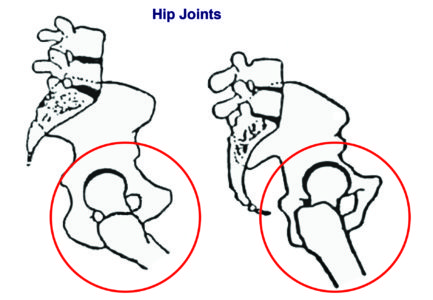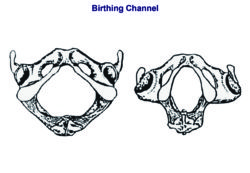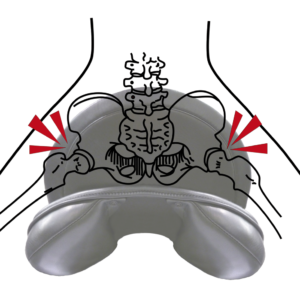Saddle Fit and Fit to the Rider
Anatomy in general is a crucial factor in saddle fit, as is gender. Men generally have it much easier when trying to find a saddle that fits, because saddles have been traditionally built by men, for men. While women may have an inherent conformational disadvantage, with exercises and muscular development (and a saddle which takes their anatomy into consideration) they could compensate and achieve a similar position on horseback to the male.

Especially in dressage it is difficult for women to achieve the classic “shoulders-hips-heels” straight line, due to the fact that the articulation of female hips is different than a man’s. It is painful to sit on the pubic bone, and as a result, most women collapse at the hip to escape the pain. The leg shoots forward, and time is spent fighting the position instead of concentrating on riding. The male hip sockets are much further forward, so that their legs can hang naturally straight down. Additionally, for most males, the upper leg (hip bone to knee bone) is pretty much the same length as the lower leg (hip
bone to ankle bone), which means that their legs will hang down straight using a ‘normal’ stirrup bar placement. (For women, the stirrup bar generally needs to be extended to allow their legs to find their centre of gravity, since most females’ upper legs are longer than their lower legs, which causes them to hang forward and pull them into the chair position even more.

Position and balance of the rider are the key ingredients in all riding disciplines; in dressage more so than in other disciplines, because the majority of time is spent sitting. The seat bones are the key structure for the foundation of position and balance, but the gluteal muscles also play a role here. Since a man’s tailbone is longer and his glutes are lower, he will not need as much support ‘behind’ at the cantle as many women will. The female almost has to ‘slouch’ in order to get the same support from her saddle. This then leads to backache, because the natural four curves in her spine cannot be properly used as shock absorbers when she rides.
For men, the position of their seat bones does not provide the obstacle it does for the majority of women. Men have two “V” shaped seat bones set close together, giving them a bipod axis. Although saddle manufacturers in the past have afforded special attention to that skeletal structure given that traditionally more men rode, it is not as complex as the woman’s requirements. Unfortunately, too many women ride in saddles built for men, which is why again you often have the above-mentioned “chair seat” as a result. Women have a broad range of hip shapes, all of which need to be accommodated when constructing a saddle. Unlike the “V” shaped man’s seat bones, women’s are usually flat. In addition, women have a more prominent and lower pubic bone. This combination of three skeletal structures causes a woman to sit as on a tripod. Herein lies the problem for most women – unless the pelvis is straight, the pommel of the saddle will inevitably interfere with the pubic bone, and unless the abdominal muscles are used, it is almost impossible to sit balanced in a saddle – with the proper support from behind.

The traditional ‘male’ saddles are built fairly widely in the crotch area, but are narrow in the seat. Women find themselves sitting with their legs pushed outwards from the hip, and/or painfully sitting on the seat seaming. The anatomy dictates that the structure for women should be exactly opposite – narrow in the crotch area (twist – which is defined as that part of the saddle between the upper inner thigh) and wider in the seat area.
For men it should be generally easy to find a saddle that fits them, because the majority of English saddles on the market today are still made as they have always been made, and will allow the male anatomy to sit comfortably and balanced. Generally speaking you are looking at a fairly wide twist and a smaller seat to accommodate his pelvis – but of course there are exceptions to every rule. Important is that the rider feels comfortable first, and then the saddle needs to be fitted to the horse (which means more than simply moving the flocking around – it needs to fit at various other key performance indicators as well such as the gullet channel, the length, etc. etc.) But if the saddle does not fit the rider and he is comfortable, then it doesn’t really matter how well the saddle fits the horse – because he will never perform to his full capability as the rider’s discomfort will translate down.
Unfortunately, for the most part, dressage saddles have not evolved terribly much over the years, except maybe cosmetically. Most companies still use the same trees, the same technology, and the same manufacturing process as they always have – with a few exceptions. This does seem somewhat paradoxical when you consider that especially in dressage the majority of riders are female – the adult amateur female rider is the market – and thankfully they are beginning to realize that a) riding doesn’t have to hurt; b) there are alternatives available and c) if they are vocal enough in their demands the industry will change!
